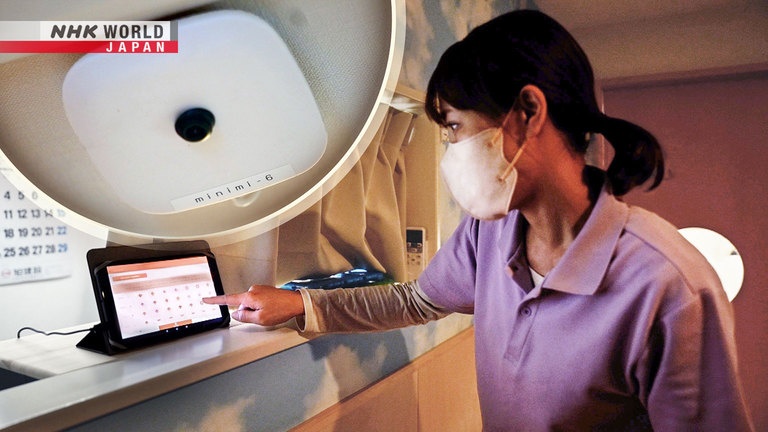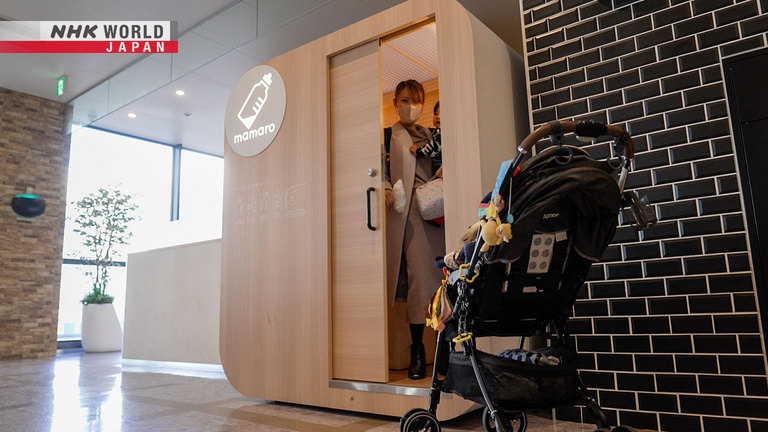Innovative Ideas in Baby Care
[SPECIAL EDITION]
This series includes selected stories from BIZ STREAM's signature "On-Site" reports. As the number of dual income families in Japan increases, the baby care market is expecting to see further growth over the next 5 years. Many of these products and services are centered on offering increased safety and improved convenience. This week's episode features a portable baby care pod and an AI-based remote infant monitoring system.
*Subtitles and transcripts are available for video segments when viewed on our website.
Innovative Ideas in Baby Care


Transcript
This small pod is positioned next to a busy food court.
It was put there to give families with infants a private place to use for feeding and changing diapers.
And a Japanese day care center is now using an AI-driven baby monitoring system,
that alerts caregivers when infants are sleeping in dangerous positions.
Today's On-site Report features businesses that are producing the next generation of baby care products.
One after another, a stream of parents and babies step into this tiny pod.
It was specifically designed to give parents a safe and private place for feeding or changing diapers.
Some shopping malls offer spacious facilities like this,
that can accommodate multiple families at once, but these require a lot of space and investment.
The pod, however, comes completely assembled.
As long as there's an outlet to plug it into, it's ready for use immediately upon delivery.
Being completely enclosed and equipped with a sturdy lock,
ensures that users have a private and secure spot to take care of their babies.
Re-arranging the stool results in a nice-sized baby bed.
Male family members are also welcome to use the pod.
A lot of men, think that the standard shared nursing rooms are just for women,
so most of us don't even think about trying to use them.
But a pod like this has a definite advantage, because it provides a totally private space.
Hasegawa Yusuke came up with the idea for the baby care pod.
He was inspired to create it after learning how hard it was not having access to baby care facilities,
whenever he took his infant son out to eat or to go shopping.
It can be really hard on parents, because babies operate on their own time,
and they let you know their hungry, or that they need something very clearly: by crying.
So when we had a small infant, we would only venture out to places that we knew offered a nursing room.
The pods sell for about $18,000, and are also available to rent for around $500 per month.
In July of 2022, a major shopping mall operator decided to try out one of the baby care pods.
They chose to place it in the food court.
Despite already offering a standard nursing room in another part of the mall,
it's located over 200 meters away from the food court.
Management hopes that by placing another option near the food court,
they can attract families with infants, who may have avoided this part of the mall, due to its distance from the nursing room.
In order to measure usage and ensure safety, the pods are equipped with sensors.
After 20 minutes have passed, a prompt will ask users to finish up and exit the pod.
If the sensors indicate someone has been inside the pod for over 30 minutes,
mall management is notified, and staff are sent to check on the users.
When we visited the mall, we came across the Fujinuma family, who were out shopping with their one-year-old son.
This was their first time to try using the baby care pod.
Fujinuma Airi says the convenience offered by the pod made her visit to the mall much more enjoyable.
After my son was born, I'd have to do research to make sure the places I wanted to visit had nursing rooms available.
Sometimes, I wouldn't even be able to eat, so having a facility so close to the food court is a huge help!
The sensors also allow the mall to keep track of how much use the pod is getting.
The busiest day recorded in 2022, was on August 21st, during the summer holiday.
From 3 pm to 4 pm, the pod was used by seven different families in a row.
This was designed to be a place for families to come eat, relax, and enjoy spending time together,
so I think it's important to offer a facility like this next to the food court.
This day care center takes care of infants up to two years old.
Every day, naptime is scheduled between noon and 3 pm.
A four-person team of employees are always present to ensure safety.
In this classroom, a camera attached to the ceiling is also helping to look over the children.
Able to recognize facial features and body part orientation, AI technology is used to monitor the babies' sleeping positions.
If it detects an infant is laying on their stomach...
By providing instant warnings of potentially dangerous positions,
the system helps the day care staff to watch over the sleeping infants.
These little ones can turn over really quickly, so when the alarm goes off,
I can shift my attention from the child I am with, and respond almost instantly.
The system was developed by Urakami Satoru.
His company specializes in providing AI-based monitoring services to healthcare providers.
After learning that infants were at risk of injury or death from dangerous sleeping positions,
he thought his company's technology might be able to make a difference.
I felt that by offering support for the most important task, which is ensuring the children's safety,
that we could give the human staff more time to focus on interacting with and caring for each and every infant.
And to help relieve them of some of their most monotonous tasks,
Urakami added another important feature specifically for the teachers.
The system documents the head position of each child while they're sleeping.
Japanese day cares are required by law to document and submit these records to the government on a regular basis,
in order to prevent any accidents from happening while the infants are sleeping.
The school requires teachers to check and record the babies' head positions every five minutes.
Currently, only the one-year-old-and-under class, has the AI monitoring system up and running.
The one-and-over class must still do the checking and documenting manually,
which keeps one staff member busy for the full duration of naptime.
Since the one-and-under class can rely on the AI system to handle that task for them,
only one staff member is needed to stay with the infants, so the others can focus their attention elsewhere.
I have a lot of other tasks and paperwork to do while the children are sleeping,
so having this monitoring system really helps to lighten my workload.
Ishimaru Yukino said that safety was one of her top priorities, when selecting which day care to take her son to.
I was so happy to learn that they use an AI monitoring system, because I know they can respond to any issue immediately.